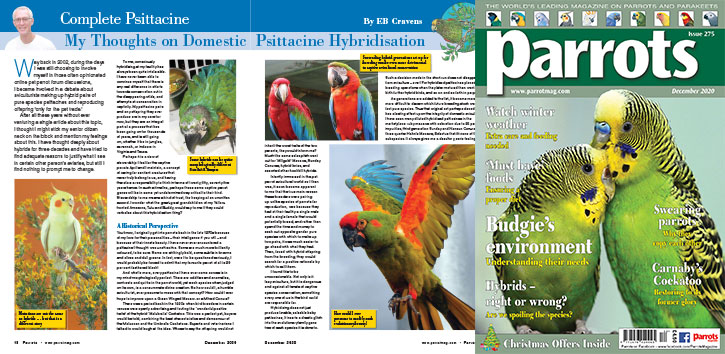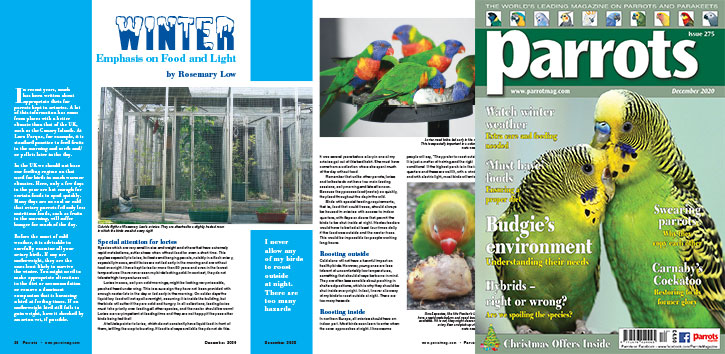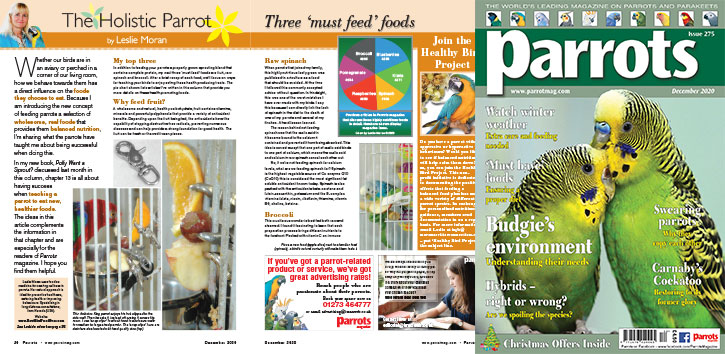
My Thoughts on Domestic Psittacine Hybridisation
Way back in 2002, during the days I was still choosing to involve myself in those often opinionated online pet parrot forum discussions, I became involved in a debate about aviculturists making up hybrid pairs of pure species psittacines and reproducing offspring ‘only for the pet trade.’
After all these years without ever venturing a single article about this topic, I thought I might stick my senior citizen neck on the block and mention my feelings about this. I have thought deeply about hybrids for three decades and have tried to find adequate reasons to justify what I see in certain other person’s aviaries, but still I find nothing to prompt me to change.
To me, consciously hybridising at my facility has always been quite intolerable. I have never been able to convince myself that there is any real difference in efforts towards conservation out in the disappearing wilds, and attempts at conservation in captivity. My psittacine pairs and any offspring they ever produce are in my care for now, but they are an integral part of a process that has been going on for thousands of years, and is still going on, whether it be in jungles, savannah, or indoors in Virginia and Texas.
Buy Now!

by Rosemary Low
In recent years, much has been written about appropriate diets for parrots kept in aviaries. A lot of this information has come from places with a better climate than that of the UK, such as the Canary Islands. At Loro Parque, for example, it is standard practice to feed fruits in the morning and seeds and/or pellets later in the day.
In the UK we should not base our feeding regime on that used for birds in much warmer climates. Here, only a few days in the year are hot enough for certain foods to spoil quickly. Many days are so cool or cold that aviary parrots fed only less nutritious foods, such as fruits in the morning, will suffer hunger for much of the day.
Before the onset of cold weather, it is advisable to carefully examine all your aviary birds. If any are underweight, they are the ones least likely to survive the winter. You might need to make appropriate alterations to the diet or accommodation or remove a dominant companion that is harassing a bird at feeding times. If an underweight bird still fails to gain weight, have it checked by an avian vet, if possible.
Buy Now!

Three ‘must feed’ foods
Whether our birds are in an aviary or perched in a corner of our living room, how we behave towards them has a direct influence on the foods they choose to eat. Because I am introducing the new concept of feeding parrots a selection of wholesome, real foods that provides them balanced nutrition, I’m sharing what the parrots have taught me about being successful when doing this.
In my new book, Polly Want a Sprout? discussed last month in this column, chapter 13 is all about having success when teaching a parrot to eat new, healthier foods. The ideas in this article complements the information in that chapter and are especially for the readers of Parrots magazine. I hope you find them helpful.
In addition to feeding your parrots a properly grown sprouting blend that contains complete protein, my next three ‘must feed’ foods are fruit, raw spinach and broccoli. After a brief recap of each food, we’ll focus on ways for teaching your birds to enjoy eating these health producing treats. The pie chart shown lists articles I’ve written in this column that provide you more details on these health promoting foods.
Buy Now!

by David Waugh, Correspondent, Loro Parque Fundación
Older generation citizens of Perth, Western Australia will recount how, back in the 1970s, thousands of big noisy parrots would flock across the horizon, flying high with deep, slow wingbeats, and gliding for extended periods with their wings held downwards. These were the sights and sounds of Carnaby’s Cockatoos (Zanda latirostris), otherwise known as Short-billed Black Cockatoos.
One can only imagine the glory of their over-flights in 1948, the year in which this type of cockatoo was described by the naturalist Ivan Carnaby. Some locals call them Rain Birds, referring to former times when the beginning of the cockatoo’s breeding season coincided with the start of the Autumn rains. For the aboriginal Noongar people, finding a Carnaby’s Cockatoo feather was, and still is, considered a blessing.
Today things have changed, and not for the better. The natural geographical distribution of Carnaby’s Cockatoo is restricted to the far south-western corner of Australia. Scientists estimate that within this region, the Carnaby’s Cockatoo population has halved in the last 45 years and has suffered a 30 per cent contraction in range, with habitat fragmentation, loss of nest hollows and lack of native food sources being the main causes. The current total population is estimated to number circa 40,000 individuals, and its decline has been sufficiently steep that it is classified in the IUCN Red List of Threatened Species as ‘Endangered’.
Buy Now!




